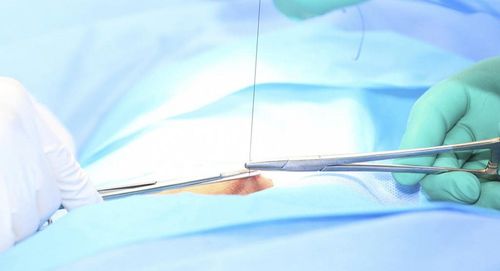This is an automatically translated article.
Fetal growth retardation is a lack of nutrition for the fetus since it was a fetus. Fetal growth retardation is diagnosed based on fetal ultrasound and fetal weight. Ultrasound of intrauterine growth retardation should be performed at at least two time points at least four weeks apart.1. What is Thai growth retardation?
Intrauterine growth retardation is a common problem, related to placental undernutrition occurring during infancy, affecting 5% - 7% of pregnancies. Fetal growth retardation is one of the most common causes of adverse perinatal outcomes, increased risk of mortality, and mental retardation.Consequences of fetal growth retardation include:
Metabolic disorders: Lack of oxygen for the fetus, lack of glucose, lack of essential amino acids for fetal development, .. Brain damage, mental and physical retardation substances, increasing the risk of diabetes and high blood pressure in adulthood. Fetal death: The perinatal mortality rate of growth retardation accounts for 40% of cases.
2. Causes of fetal growth retardation
Causes of fetal growth retardation in utero include:Fetal causes: Heredity, chromosomal abnormalities, birth defects, multiple pregnancies. Maternal causes: Having chronic diseases such as high blood pressure, heart failure, kidney failure, malnutrition. Causes of the placenta: Abnormal uterus, placental adhesions, placental dysfunction. Other causes: Alcohol, drugs, tobacco, infection.
3. Diagnosis of fetal growth retardation
Diagnosis of fetal growth retardation is based on fetal ultrasound, but there is no clear criterion. However, clinically this condition is usually suspected if the fetus has low birth weight, oligohydramnios, and umbilical artery doppler abnormalities.Intrauterine growth retardation when fetal weight is below the 10th percentile for gestational age on fetal ultrasound. Oliguria if the largest amniotic cavity is measured < 2 cm or the largest amniotic cavity volume is less than 15 cm2. Umbilical artery doppler abnormalities: Increased umbilical artery resistance, loss or reversal of umbilical artery diastolic waves.

Siêu âm thai chậm tăng trưởng trong tử cung là điều quan trọng
3. Ultrasound application of intrauterine growth retardation
Fetal ultrasound plays an important role in detecting risk groups, detecting fetal growth retardation, causes of placental insufficiency and assessing fetal status as well as choosing appropriate treatment.Ultrasound estimates fetal weight by measuring fetal size. Fetal ultrasound assessment of placental function includes: Doppler ultrasound of the umbilical and uterine arteries.
Fetal ultrasound to assess fetal health including: Doppler ultrasound of the middle cerebral artery and ductus venosus.
3.1 Fetal size ultrasound Measuring head and rump length (CRL): Measurements between 6 and 12 weeks are the most reliable. If not within the normal value for week of pregnancy, fetal morphological disorder or chromosomal abnormality should be suspected Biparietal Diameter (BPD): Measurement time ranges from 9th to 8th week 11 of pregnancy . Through multiple fetal ultrasounds, a development chart of the measured values is drawn. Fetal weight is within the normal range when the histogram is between the 10th and 90th percentile lines. If the chart is below the 10th percentile, the fetus is small, suggesting growth retardation. 3.2 Uterine artery doppler ultrasound Uterine artery doppler ultrasound is performed around 18-22 weeks of pregnancy, helping to screen for risk groups and diagnose the cause.
During pregnancy, uterine artery impedance decreases, with RI < 0.58 and PI < 1. If the uterine artery impedance is increased, the presence of an early diastolic defect indicates impaired uteroplacental circulation.
Uterine artery doppler ultrasound combined with clinical features can detect early fetal growth retardation in up to 90% of cases.
3.2 Umbilical artery doppler ultrasound An umbilical doppler ultrasound was performed multiple times in all three trimesters, assessing umbilical artery resistance and placental vascular resistance as the ratio of end-systolic to diastolic velocity. (S/D ratio).
Umbilical artery resistance is the only parameter that both helps diagnose and predict fetal growth retardation for timely treatment. An increase in umbilical artery resistance indicates 30% destruction of the placental arterioles. Loss or reversal of umbilical artery diastolic waves means that 70% of the placental arterioles are destroyed. At that time, the fetal prognosis is very poor, the risk of death within 24 hours.
3.4 Middle cerebral artery doppler ultrasound Middle cerebral artery doppler ultrasound is an indicator of fetal hypoxia, reflects health status and predicts outcome. Unusual in the presence of cerebrovascular dilatation, but valid only in late-onset growth retardation.
3.5 Tubular doppler ultrasound Tubular doppler ultrasound shows that if the fetus is severely hypoxic, it will redistribute blood from the umbilical vein into the ductus venosus, increasing cardiac output, increasing the resistance of the ductus venosus. Umbilical vein doppler parameter has predictive value of impending fetal death in late-onset growth retardation.
Fetal growth retardation due to placental undernourishment occurring from the time of conception. Ultrasound of intrauterine growth retardation helps to identify risk groups, diagnose and treat appropriately.

Siêu âm thai đóng vai trò quan trọng trong phát hiện thai chậm tăng trưởng
In addition, at Vinmec, we also perform intensively Double Test or Triple Test tests to screen for fetal malformations; Quantitative angiogenesis factor test to diagnose preeclampsia; thyroid screening test; Rubella test; testing for parasites that are transmitted from mother to child, which seriously affects the baby's brain and physical development after birth...
After birth, the baby will be cared for in a sterile room before being brought back back to mom. Pregnant women will rest in a high-class hospital room, designed according to international hotel standards, 1 mother 1 room with full facilities and modern equipment. Mothers will be consulted by nutritionists on how to feed the baby before being discharged from the hospital. Postpartum follow-up with both mother and baby with leading Obstetricians and Paediatricians.
Please dial HOTLINE for more information or register for an appointment HERE. Download MyVinmec app to make appointments faster and to manage your bookings easily.













